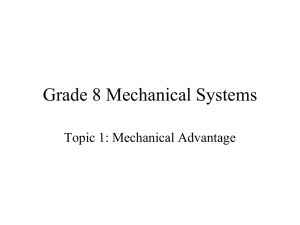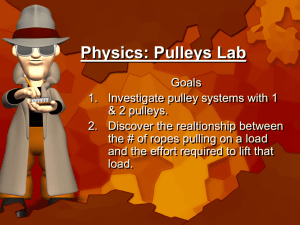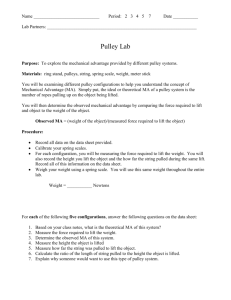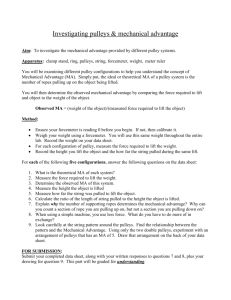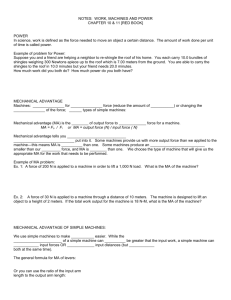Levers and levers in human body
advertisement
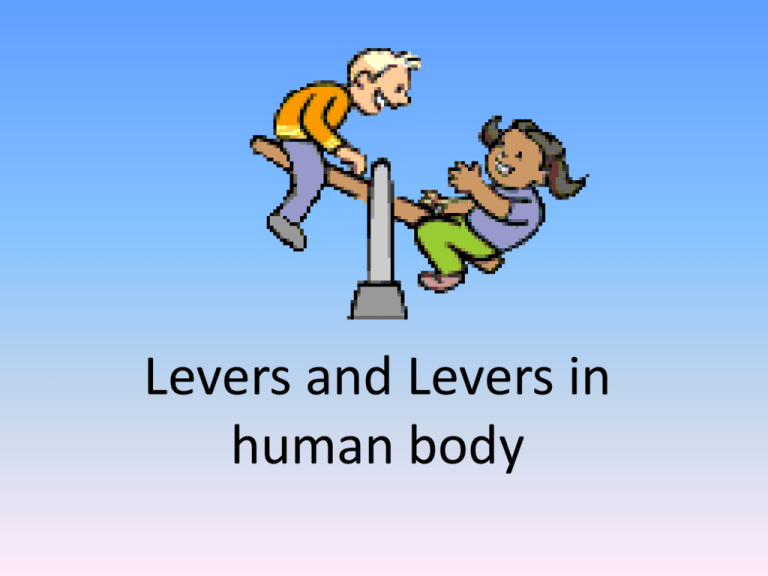
Levers and Levers in human body Lever • Lever is a length of solid materials that is use to apply force to another object or • Rigid structure that rotates around a fixed point • Levers has 3 parts – Force (effort) – Resistance (load) – Axis (fulcrum) • FA (Force arm – Distance between force and axis • RA (Resistance arm) – Distance between resistance and axis • Arrangement of Force arm & Resistance arm determines type of lever Types of Levers • There are 3 types of levers – First class levers – Second class levers – Third class levers First class Lever • Axis located between force and resistance • If axis is closer to resistance, RA shorter and FA will be longer. • Easy to move • If axis is closer to force opposite will occur • Most efficient class of lever • BALANCE Examples for 1st class levers • Seesaw • Scissor • Hammer removing a nail Examples in human body • Skull pivoting on the atlas vertebrae of the spine, with weight of the head held by the trapezius and sternocleidomastoid muscle of the muscle of the neck. Second class Lever • Axis at one end, resistance in middle, force at other end • POWER / force Examples for 2nd class levers Examples in human body • Action of the ball of the foot with the gastrocnemius & soleus muscles of the calf lifting the weight of the body, which acting through foot during plantar flexion • Push ups Third class levers • Axis at one end, force in middle, resistance at opposite end • Most common in the body • ROM / Speed Examples for 3rd class levers Base ball bat Opening a door Examples in human body • Action of biceps muscles as it lifts a load in the hand whilst pivoting elbow • Action of hamstring muscle MECHANICAL ADVANTAGE • • • • • Ratio between force arm and resistance arm MA = FA/RA Force Arm > Resistance arm= MA is >1 Force arm < Resistance Arm = MA is <1 The Greater the Mechanical Advantage, the less force is needed to cause motion! Calculate the Mechanical Advantage • A man is lifting 4kg from his elbow. Length of forearm up to the weight is 15cm and length of the biceps muscle is 30cm. • Athlete is doing pushups. Distance from his toes to COG is 90cm and toes to hands on pushups are 150cm. Mechanical disadvantage • In third class levers due to the attachment of muscle close to the fulcrum much more force than load force should be provided to lift the weight Pulleys Pulleys • Definition - a simple machine that consists of a rope that fits into a groove in a wheel. - can change size, direction of input force or both • 3 Types of Pulleys - fixed pulleys - moveable pulleys - pulley system Single Fixed Pulley • This pulley provides the user Directional Advantage, allowing someone to pull down to lift the load up. • Is Mechanical Advantage provided with this system? No • Effort needed to lift this load is equal to the weight of the load. • Load is supported by only 1 rope arm. • Have to pull an amount of rope equal to the height you wish to lift the load Single Moveable Pulley This pulley system provides Mechanical Advantage, requiring only ½ the effort needed to lift the weight of the load. The load is supported by 2 rope arms under the pulley. Each load arm supports half the weight of the load, so the arm pulling up uses only 10 lbs of effort to lift this load. Length of pull twice as much rope as desired to lift the load a certain height. Example: Pull 2 ft of rope for each 1 foot of height that want to lift the load. Single Fixed/Single Moveable Pulley This pulley system combines the properties of their single components into a system that provides both Mechanical and Directional Advantage. This pulley provides Directional Advantage by allowing the user to pull down to lift the load. It also provides Mechanical Advantage by using 2 rope arms to support the load, reducing the effort needed to lift the load by ½. In this system length of pull 2 times as much rope for every unit of height that you want to lift the load. Pulley Power! Single-Fixed Pulleys provide or Directional Advantage. You can make use of Counter-Weights in order to reduce your effort needed to lift the load. However, your effort PLUS the counter-weight together must be equal to or be more than the weight of the load being lifted. Single-Moveable Pulleys provide Mechanical Advantage. You must pull 2 times the distance in rope that you wish to lift the load because the load is supported by 2 rope arms. You gain a Mechanical Advantage of 2 because you are using only ½ as much effort to lift the load. . Combining Single-Fixed and Single-Moveable into Compound Pulley Systems allows the user to gain both Mechanical and Directional Advantage. The more rope arms supporting the load the greater the Mechanical Advantage
